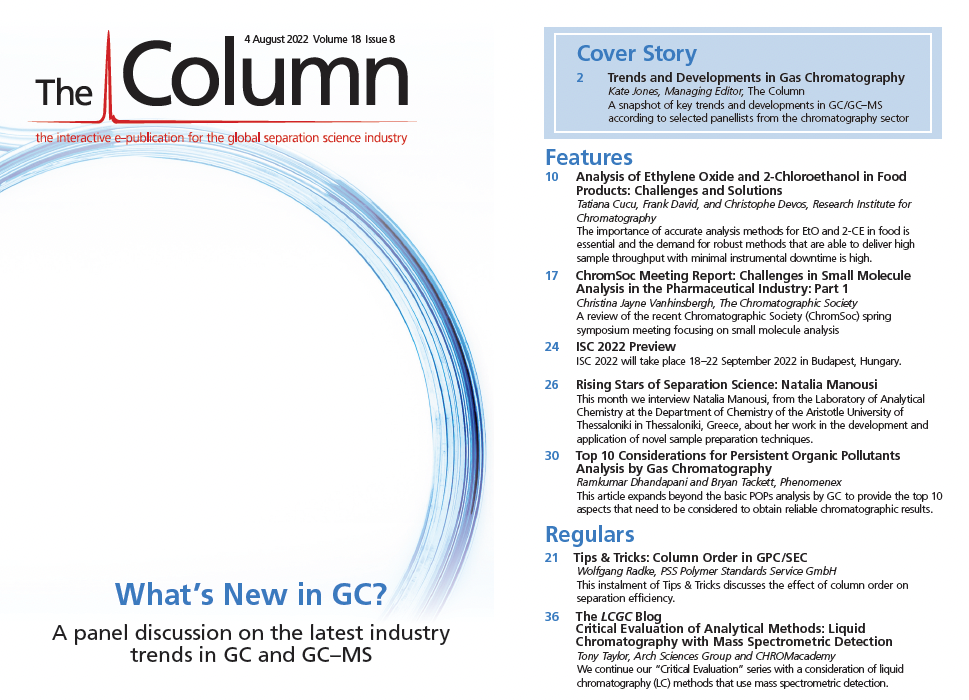Miniaturized Nano-HPLC–ESI-IMS System for Water Analysis
Miniaturized LC systems offer the analyst the scope to use less organic solvent and consume less energy. As the demand for green chemistry techniques and methods continues to grow there is demand for smaller and more portable liquid chromatography (LC) analytical instruments.
Miniaturized LC systems offer the analyst the scope to use less organic solvent and consume less energy. As the demand for green chemistry techniques and methods continues to grow there is demand for smaller and more portable liquid chromatography (LC) analytical instruments. Ion mobility spectrometry (IMS) does not require a vacuum to separate the generated ions and this makes smaller analytical instruments an achievable goal (1). Gas chromatography (GC) has been successfully combined with IMS for portable applications (2–3).
Consequently, a portable LC–IMS system would be a useful tool in environmental analysis, and German researchers are developing a portable miniaturized nano-high performance liquid chromatography–electrospray ionization-ion mobility spectrometer (HPLC–ESI-IMS) system to potentially analyze pollutants in water (1).
The system splitlessly combines a modern nano-LC system with a self-constructed ESI-MS unit and also integrates online enrichment using solid-phase extraction (SPE) to improve sensitivity for a mixture of six analytes prepared in a test mixture containing chlortoluron, isoputuron, pyrimethanil, mepanipyrim, cyprodinil, and carbemazipine.
The researchers also assessed ethanol as an organic solvent for the mobile phase and found that better ionization was achieved compared with acetonitrile for the analytes selected. The researchers concluded that a 2D separation based on LC and IMS offers a useful approach to analyze complex mixtures. An orthogonality value of 0.53 and an effective 2D peak capacity of 174 were reported. The team concluded that this prototype could possibly be developed into a device that could be used at sites of accidents or disasters with water pollution to provide rapid, on-site analysis.
The AGREE tool was used by the rearchers to assess the “greenness” of this method. The new analytical procedure achieved a value of 0.73 in a system where 1.00 corresponds to the “ideal” green system. For the previous method using a standard LC–mass spectrometry (MS) system and acetonitrile as the mobile phase a lower rating of 0.47 was calculated.
References
- T. Tutenberg et al., Green Analytical Chemistry 1(4),
100011 (2022). - J.M. Almirral, Forensic Chem. 19(6), 100240 (2020).
- P.E. Leary, B.W. Kammerath, and J.F. Reffner, Portable Spectroscopy and Spectrometry 367–389 (2021).

Thermodynamic Insights into Organic Solvent Extraction for Chemical Analysis of Medical Devices
April 16th 2025A new study, published by a researcher from Chemical Characterization Solutions in Minnesota, explored a new approach for sample preparation for the chemical characterization of medical devices.
Sorbonne Researchers Develop Miniaturized GC Detector for VOC Analysis
April 16th 2025A team of scientists from the Paris university developed and optimized MAVERIC, a miniaturized and autonomous gas chromatography (GC) system coupled to a nano-gravimetric detector (NGD) based on a NEMS (nano-electromechanical-system) resonator.
Miniaturized GC–MS Method for BVOC Analysis of Spanish Trees
April 16th 2025University of Valladolid scientists used a miniaturized method for analyzing biogenic volatile organic compounds (BVOCs) emitted by tree species, using headspace solid-phase microextraction coupled with gas chromatography and quadrupole time-of-flight mass spectrometry (HS-SPME-GC–QTOF-MS) has been developed.
A Guide to (U)HPLC Column Selection for Protein Analysis
April 16th 2025Analytical scientists are faced with the task of finding the right column from an almost unmanageable range of products. This paper focuses on columns that enable protein analysis under native conditions through size exclusion, hydrophobic interaction, and ion exchange chromatography. It will highlight the different column characteristics—pore size, particle size, base matrices, column dimensions, ligands—and which questions will help decide which columns to use.
















